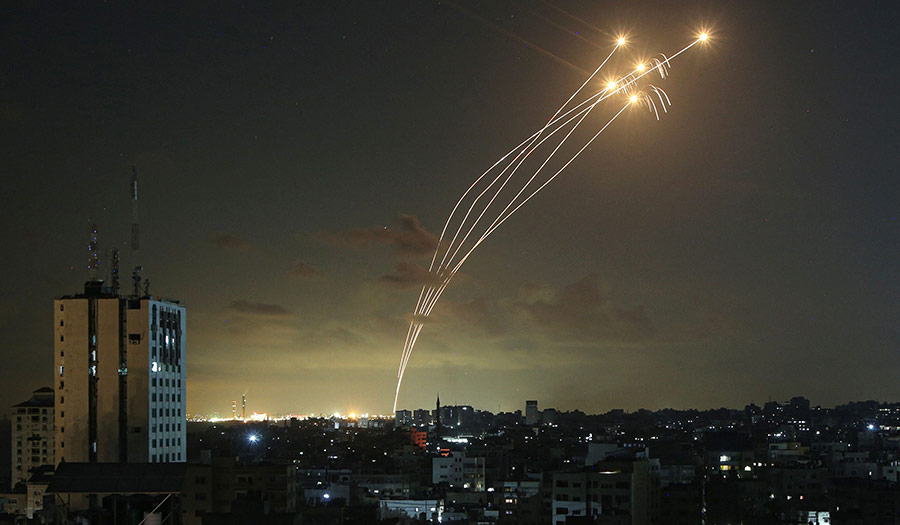 AP/Fatima Shbair
AP/Fatima Shbair
World News Desk
Learn the why behind the headlines.
Subscribe to the Real Truth for FREE news and analysis.
Subscribe NowAssociated Press – Catastrophic hunger is so dire in two world hotspots that famine is imminent in northern Gaza and approaching in Haiti, with hundreds of thousands of people in both places struggling to avoid starvation.
That is according to international food security experts and aid groups, who are warning about the toll from hunger caused by the ongoing war between Israel and Hamas in Gaza and the crisis in Haiti caused by gangs attacking the country’s key government institutions.
In Gaza, virtually every resident is struggling to get enough food and 1.1 million people—half the population—are expected to face the highest level of severe hunger in coming weeks, according to a report from the Integrated Food Security Phase Classification, an agency that monitors hunger globally. On Monday, the group warned that famine could occur in Gaza any time between mid-March and May without an end to hostilities and immediate access to essential supplies and services.
In Haiti, about 1.4 million people are on the verge of famine and more than 4 million need help accessing food, aid groups say.
But what does it mean for a region to fall into famine? And how could it happen in these places so fast? Here is what you need to know.
What Is Famine?
The IPC, a group of 15 global organizations and charities, was developed in 2004 during the famine in Somalia. The group uses a five-tier scale to monitor access to food and levels of hunger.
Famine is the top tier, Phase 5, “the absolute inaccessibility of food to an entire population or sub-group of a population, potentially causing death in the short term.”
It occurs when 20 percent of households have an extreme lack of food, 30 percent of children suffer from acute malnutrition and at least two adults or four children per every 10,000 people die daily because of outright starvation or the interaction of malnutrition and disease.
That top level follows the Phase 3 “crisis” and Phase 4 “emergency” levels of food need. Worldwide, nearly 158 million people face crisis hunger situations or worse, according to the IPC.
While the depth of the food crises in both places is new, the underlying conditions are not, said Tobias Stillman, director of technical services and innovation at the aid group Action Against Hunger, via email.
Even before the war, 80 percent of Gazans relied on humanitarian aid and nearly half of all households did not have enough food, he said. In Haiti, millions were already coping with emergency levels of hunger and crisis levels of food need.
“When families and entire nations live so close to the brink, it is all too easy for conflict or other shocks to push them into catastrophe,” Mr. Stillman said.
What Are Hunger, Malnutrition and Starvation?
Hunger is the informal term for the feeling that occurs “when our bodies need or expect food,” Mr. Stillman said. Aid groups say hunger occurs when people cannot afford or physically obtain sufficient nutrition for an extended period of time.
Malnutrition is a medical condition that occurs when people do not get the right calories to grow and function properly, leading to health problems. The deadliest form of malnutrition is severe acute malnutrition, which occurs when children are too thin for their height.
“This can happen suddenly, caused by a severe hunger crisis, or it can occur over time,” Mr. Stillman said.
Starvation is not a technical term, but it describes extreme suffering or death caused by lack of food.
Death from starvation can come “surprisingly quickly,” Mr. Stillman said. Without food, the body uses carbohydrates and fats first, then turns to breaking down protein, including muscle and vital organs. The body begins to shut down functions, including digestion, which makes it harder to absorb any nutrients that are available. People suffer from extreme fatigue and become listless as the body tries to conserve energy.
Without specialized treatment, organs stop functioning and the body’s defenses cannot fight infection. Many times, people without food die of common infections. If that does not happen, vital organs shut down and the heart stops.
Who Is Most Vulnerable?
Children younger than 5, pregnant and breastfeeding women, the elderly and people with underlying health conditions are most at risk from malnutrition. In acute crises like that seen in Gaza, malnutrition affects the youngest children first, experts said.
What Happens if Famine Is Declared?
A declaration of famine would be made by top United Nations officials based on the IPC criteria. Such a declaration carries no binding obligations on UN members or states, but serves to focus global attention on the problem.
- Real Truth Magazine Articles
- MIDDLE EAST
 Israel vs. Hamas: 4,000 Years in the Making
Israel vs. Hamas: 4,000 Years in the Making
More on Related Topics:
- Corruption Survey Gives Many Nations Their Worst Scores in Over a Decade
- Tariff Threats Take Aim at Fentanyl Trafficking. Here Is How the Drug Reaches the U.S.
- More Aid Workers Have Been Killed in 2024 Than in Any Other Year, UN Says
- Vladimir Putin Touts Russia’s New Missile and Delivers a Menacing Warning to NATO
- Top War-crimes Court Issues Arrest Warrants for Benjamin Netanyahu and Others in Israel-Hamas Fighting


